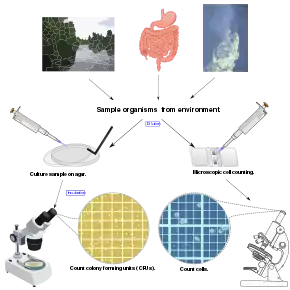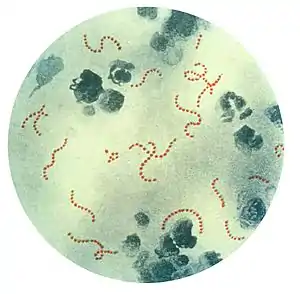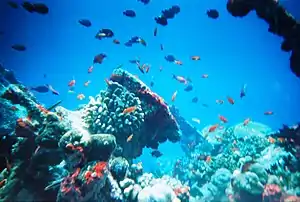Microbial ecology
Microbial ecology (or environmental microbiology) is the ecology of microorganisms: their relationship with one another and with their environment. It concerns the three major domains of life—Eukaryota, Archaea, and Bacteria—as well as viruses.[2]

Microorganisms, by their omnipresence, impact the entire biosphere. Microbial life plays a primary role in regulating biogeochemical systems in virtually all of our planet's environments, including some of the most extreme, from frozen environments and acidic lakes, to hydrothermal vents at the bottom of deepest oceans, and some of the most familiar, such as the human small intestine.[3][4] As a consequence of the quantitative magnitude of microbial life (calculated as 5.0×1030 cells; eight orders of magnitude greater than the number of stars in the observable universe[5][6]) microbes, by virtue of their biomass alone, constitute a significant carbon sink.[7] Aside from carbon fixation, microorganisms' key collective metabolic processes (including nitrogen fixation, methane metabolism, and sulfur metabolism) control global biogeochemical cycling.[8] The immensity of microorganisms' production is such that, even in the total absence of eukaryotic life, these processes would likely continue unchanged.[9]
History
While microbes have been studied since the seventeenth-century, this research was from a primarily physiological perspective rather than an ecological one.[10] For instance, Louis Pasteur and his disciples were interested in the problem of microbial distribution both on land and in the ocean.[11] Martinus Beijerinck invented the enrichment culture, a fundamental method of studying microbes from the environment. He is often incorrectly credited with framing the microbial biogeographic idea that "everything is everywhere, but, the environment selects", which was stated by Lourens Baas Becking.[12] Sergei Winogradsky was one of the first researchers to attempt to understand microorganisms outside of the medical context—making him among the first students of microbial ecology and environmental microbiology—discovering chemosynthesis, and developing the Winogradsky column in the process.[13]:644
Beijerinck and Windogradsky, however, were focused on the physiology of microorganisms, not the microbial habitat or their ecological interactions.[10] Modern microbial ecology was launched by Robert Hungate and coworkers, who investigated the rumen ecosystem. The study of the rumen required Hungate to develop techniques for culturing anaerobic microbes, and he also pioneered a quantitative approach to the study of microbes and their ecological activities that differentiated the relative contributions of species and catabolic pathways.[10]
Progress in microbial ecology has been tied to development of new technologies. The measurement of biogeochemical process rates in nature was driven by the availability of radioisotopes beginning in the 1950s. For example, 14CO2 allowed analysis of rates of photosynthesis in the ocean (ref). Another significant breakthrough came in the 1980s, when microelectrodes sensitive to chemical species like O2 were developed.[14] These electrodes have a spatial resolution of 50–100 μm, and have allowed analysis of spatial and temporal biogeochemical dynamics in microbial mats and sediments.
Although measuring biogeochemical process rates could analyze what processes were occurring, they were incomplete because they provided no information on which specific microbes were responsible. It was long known that ‘classical’ cultivation techniques recovered fewer than 1% of the microbes from a natural habitat. However, beginning in the 1990s, a set of cultivation-independent techniques have evolved to determine the relative abundance of microbes in a habitat. Carl Woese first demonstrated that the sequence of the 16S ribosomal RNA molecule could be used to analyze phylogenetic relationships. Norm Pace took this seminal idea and applied it to analyze ‘who’s there’ in natural environments. The procedure involves (a) isolation of nucleic acids directly from a natural environment, (b) PCR amplification of small subunit rRNA gene sequences, (c) sequencing the amplicons, and (d) comparison of the those sequences to a database of sequences from pure cultures and environmental DNA.[15] This has provided tremendous insights into the diversity present within microbial habitats. However, it does not resolve how to link specific microbes to their biogeochemical role. Metagenomics, the sequencing of total DNA recovered from an environment, can provide insights into biogeochemical potential,[16] whereas metatranscriptomics and metaproteomics can measure actual expression of genetic potential but remains more technically difficult.[17]
Roles
Microorganisms are the backbone of all ecosystems, but even more so in the zones where photosynthesis is unable to take place because of the absence of light. In such zones, chemosynthetic microbes provide energy and carbon to the other organisms. These chemotrophic organisms can also function in environments lacking oxygen by using other electron acceptors for their respiration.
Other microbes are decomposers, with the ability to recycle nutrients from other organisms' waste products. These microbes play a vital role in biogeochemical cycles.[18] The nitrogen cycle, the phosphorus cycle, the sulphur cycle and the carbon cycle all depend on microorganisms in one way or another. For example, the nitrogen gas which makes up 78% of the earth's atmosphere is unavailable to most organisms, until it is converted to a biologically available form by the microbial process of nitrogen fixation.
Due to the high level of horizontal gene transfer among microbial communities,[19] microbial ecology is also of importance to studies of evolution.[20]
Symbiosis
Microbes, especially bacteria, often engage in symbiotic relationships (either positive or negative) with other microorganisms or larger organisms. Although physically small, symbiotic relationships amongst microbes are significant in eukaryotic processes and their evolution.[21][22] The types of symbiotic relationship that microbes participate in include mutualism, commensalism, parasitism,[23] and amensalism,[24] and these relationships affect the ecosystem in many ways.
Mutualism
Mutualism in microbial ecology is a relationship between microbial species and humans that allow for both sides to benefit.[25] One such example would be syntrophy, also known as cross-feeding,[24] of which 'Methanobacterium omelianskii ' is a classical example.[26][27] This consortium is formed by an ethanol fermenting organism and a methanogen. The ethanol-fermenting organism provides the archaeal partner with the H2, which this methanogen needs in order to grow and produce methane.[21][27] Syntrophy has been hypothesized to play a significant role in energy- and nutrient-limited environments, such as deep subsurface, where it can help the microbial community with diverse functional properties to survive, grow and produce maximum amount of energy.[28][29] Anaerobic oxidation of methane (AOM) is carried out by mutualistic consortium of a sulfate-reducing bacterium and an anaerobic methane-oxidizing archaeon. [30][31] The reaction used by the bacterial partner for the production of H2 is endergonic (and so thermodynamically unfavored) however, when coupled to the reaction used by archaeal partner, the overall reaction becomes exergonic.[21] Thus the two organisms are in a mutualistic relationship which allows them to grow and thrive in an environment, deadly for either species alone. Lichen is an example of a symbiotic organism.[27]
Commensalism
Commensalism is very common in microbial world, literally meaning "eating from the same table".[32] Metabolic products of one microbial population are used by another microbial population without either gain or harm for the first population. There are many "pairs "of microbial species that perform either oxidation or reduction reaction to the same chemical equation. For example, methanogens produce methane by reducing CO2 to CH4, while methanotrophs oxidize methane back to CO2. [33]
Amensalism
Amensalism (also commonly known as antagonism) is a type of symbiotic relationship where one species/organism is harmed while the other remains unaffected.[25] One example of such a relationship that takes place in microbial ecology is between the microbial species Lactobacillus casei and Pseudomonas taetrolens.[34] When co-existing in an environment, Pseudomonas taetrolens shows inhibited growth and decreased production of lactobionic acid (its main product) most likely due to the byproducts created by Lactobacillus casei during its production of lactic acid.[35] However, Lactobacillus casei shows no difference in its behaviour, and such this relationship can be defined as amensalism.
Microbial resource management
Biotechnology may be used alongside microbial ecology to address a number of environmental and economic challenges. For example, molecular techniques such as community fingerprinting or metagenomics can be used to track changes in microbial communities over time or assess their biodiversity. Managing the carbon cycle to sequester carbon dioxide and prevent excess methanogenesis is important in mitigating global warming, and the prospects of bioenergy are being expanded by the development of microbial fuel cells. Microbial resource management advocates a more progressive attitude towards disease, whereby biological control agents are favoured over attempts at eradication. Fluxes in microbial communities has to be better characterized for this field's potential to be realised.[36] In addition, there are also clinical implications, as marine microbial symbioses are a valuable source of existing and novel antimicrobial agents, and thus offer another line of inquiry in the evolutionary arms race of antibiotic resistance, a pressing concern for researchers.[37]
In built environment and human interaction
Microbes exist in all areas, including homes, offices, commercial centers, and hospitals. In 2016, the journal Microbiome published a collection of various works studying the microbial ecology of the built environment.[38]
A 2006 study of pathogenic bacteria in hospitals found that their ability to survive varied by the type, with some surviving for only a few days while others survived for months.[39]
The lifespan of microbes in the home varies similarly. Generally bacteria and viruses require a wet environment with a humidity of over 10 percent.[40] E. coli can survive for a few hours to a day.[40] Bacteria which form spores can survive longer, with Staphylococcus aureus surviving potentially for weeks or, in the case of Bacillus anthracis, years.[40]
In the home, pets can be carriers of bacteria; for example, reptiles are commonly carriers of salmonella.[41]
S. aureus is particularly common, and asymptomatically colonizes about 30% of the human population;[42] attempts to decolonize carriers have met with limited success[43] and generally involve mupirocin nasally and chlorhexidine washing, potentially along with vancomycin and cotrimoxazole to address intestinal and urinary tract infections.[44]
Antimicrobials
Some metals, particularly copper and silver, have antimicrobial properties. Using antimicrobial copper-alloy touch surfaces is a technique which has begun to be used in the 21st century to prevent transmission of bacteria.[45] Silver nanoparticles have also begun to be incorporated into building surfaces and fabrics, although concerns have been raised about the potential side-effects of the tiny particles on human health.[46]
See also
References
- Hugenholtz, P. (2002). "Exploring prokaryotic diversity in the genomic era". Genome Biology. 3 (2): reviews0003.reviews0001. doi:10.1186/gb-2002-3-2-reviews0003. PMC 139013. PMID 11864374.
- Barton, Larry L.; Northup, Diana E. (9 September 2011). Microbial Ecology. Wiley-Blackwell. Oxford: John Wiley & Sons. p. 22. ISBN 978-1-118-01582-7. Retrieved 25 May 2013.
- Bowler, Chris; Karl, David M.; Colwell, Rita R. (2009). "Microbial oceanography in a sea of opportunity". Nature. 459 (7244): 180–4. Bibcode:2009Natur.459..180B. doi:10.1038/nature08056. PMID 19444203.
- Konopka, Allan (2009). "What is microbial community ecology?". The ISME Journal. 3 (11): 1223–30. doi:10.1038/ismej.2009.88. PMID 19657372.
- Whitman, W. B.; Coleman, DC; Wiebe, WJ (1998). "Prokaryotes: The unseen majority". Proceedings of the National Academy of Sciences. 95 (12): 6578–83. Bibcode:1998PNAS...95.6578W. doi:10.1073/pnas.95.12.6578. JSTOR 44981. PMC 33863. PMID 9618454.
- "number of stars in the observable universe - Wolfram|Alpha". Retrieved 2011-11-22.
- Reddy, K. Ramesh; DeLaune, Ronald D. (15 July 2004). Biogeochemistry of Wetlands: Science and Applications. Boca Raton: Taylor & Francis. p. 116. ISBN 978-0-203-49145-4. Retrieved 25 May 2013.
- Delong, Edward F. (2009). "The microbial ocean from genomes to biomes" (PDF). Nature. 459 (7244): 200–6. Bibcode:2009Natur.459..200D. doi:10.1038/nature08059. hdl:1721.1/69838. PMID 19444206.
- Lupp, Claudia (2009). "Microbial oceanography". Nature. 459 (7244): 179. Bibcode:2009Natur.459..179L. doi:10.1038/459179a. PMID 19444202.
- Konopka, A. (2009). "Ecology, Microbial". Encyclopedia of Microbiology. pp. 91–106. doi:10.1016/B978-012373944-5.00002-X. ISBN 978-0-12-373944-5.
- Adler, Antony; Dücker, Erik (2017-04-05). "When Pasteurian Science Went to Sea: The Birth of Marine Microbiology". Journal of the History of Biology. 51 (1): 107–133. doi:10.1007/s10739-017-9477-8. ISSN 0022-5010. PMID 28382585.
- De Wit, Rutger; Bouvier, Thierry (2006). "'Everything is everywhere, but, the environment selects'; what did Baas Becking and Beijerinck really say?". Environmental Microbiology. 8 (4): 755–8. doi:10.1111/j.1462-2920.2006.01017.x. PMID 16584487.
- Madigan, Michael T. (2012). Brock biology of microorganisms (13th ed.). San Francisco: Benjamin Cummings. ISBN 9780321649638.
- Revsbech, Niels Peter; Jørgensen, Bo Barker (1986), Marshall, K. C. (ed.), "Microelectrodes: Their Use in Microbial Ecology", Advances in Microbial Ecology, Boston, MA: Springer US, 9, pp. 293–352, doi:10.1007/978-1-4757-0611-6_7, ISBN 978-1-4757-0613-0, retrieved 2020-09-21
- Hugerth, Luisa W.; Andersson, Anders F. (2017). "Analysing Microbial Community Composition through Amplicon Sequencing: From Sampling to Hypothesis Testing". Frontiers in Microbiology. 8. doi:10.3389/fmicb.2017.01561. ISSN 1664-302X.
- New, Felicia N.; Brito, Ilana L. (2020-09-08). "What Is Metagenomics Teaching Us, and What Is Missed?". Annual Review of Microbiology. 74 (1): 117–135. doi:10.1146/annurev-micro-012520-072314. ISSN 0066-4227.
- Shakya, Migun; Lo, Chien-Chi; Chain, Patrick S. G. (2019). "Advances and Challenges in Metatranscriptomic Analysis". Frontiers in Genetics. 10. doi:10.3389/fgene.2019.00904. ISSN 1664-8021.
- Fenchel, Tom; Blackburn, Henry; King, Gary M. (24 July 2012). Bacterial Biogeochemistry: The Ecophysiology of Mineral Cycling (3 ed.). Boston, Mass.: Academic Press/Elsevier. p. 3. ISBN 978-0-12-415974-7. Retrieved 25 May 2013.
- McDaniel, L. D.; Young, E.; Delaney, J.; Ruhnau, F.; Ritchie, K. B.; Paul, J. H. (2010). "High Frequency of Horizontal Gene Transfer in the Oceans". Science. 330 (6000): 50. Bibcode:2010Sci...330...50M. doi:10.1126/science.1192243. PMID 20929803.
- Smets, Barth F.; Barkay, Tamar (2005). "Horizontal gene transfer: Perspectives at a crossroads of scientific disciplines". Nature Reviews Microbiology. 3 (9): 675–8. doi:10.1038/nrmicro1253. PMID 16145755.
- L., Kirchman, David (2012). Processes in microbial ecology. Oxford: Oxford University Press. ISBN 9780199586936. OCLC 777261246.
- López-García, Purificación; Eme, Laura; Moreira, David (2017-12-07). "Symbiosis in eukaryotic evolution". Journal of Theoretical Biology. The origin of mitosing cells: 50th anniversary of a classic paper by Lynn Sagan (Margulis). 434 (Supplement C): 20–33. doi:10.1016/j.jtbi.2017.02.031. PMC 5638015. PMID 28254477.
- I., Krasner, Robert (2010). The microbial challenge : science, disease, and public health (2nd ed.). Sudbury, Mass.: Jones and Bartlett Publishers. ISBN 978-0763756895. OCLC 317664342.
- Faust, Karoline; Raes, Jeroen (16 July 2012). "Microbial interactions: from networks to models". Nature Reviews. Microbiology. 10 (8): 538–550. doi:10.1038/nrmicro2832. PMID 22796884.
- Sheela., Srivastava (2003). Understanding bacteria. Srivastava, P. S. (Prem S.). Dordrecht: Kluwer Academic Publishers. ISBN 978-1402016332. OCLC 53231924.
- Bryant, M. P.; Wolin, E. A.; Wolin, M. J.; Wolfe, R. S. (1967). "Methanobacillus omelianskii, a symbiotic association of two species of bacteria". Archiv für Mikrobiologie. 59 (1–3): 20–31. doi:10.1007/bf00406313. ISSN 0302-8933. PMID 5602458.
- López-García, Purificación; Eme, Laura; Moreira, David (December 2017). "Symbiosis in eukaryotic evolution". Journal of Theoretical Biology. The origin of mitosing cells: 50th anniversary of a classic paper by Lynn Sagan (Margulis). 434 (Supplement C): 20–33. doi:10.1016/j.jtbi.2017.02.031. PMC 5638015. PMID 28254477.
- Lau, Maggie C. Y.; Kieft, Thomas L.; Kuloyo, Olukayode; Linage-Alvarez, Borja; van Heerden, Esta; Lindsay, Melody R.; Magnabosco, Cara; Wang, Wei; Wiggins, Jessica B.; Guo, Ling; Perlman, David H. (2016-12-06). "An oligotrophic deep-subsurface community dependent on syntrophy is dominated by sulfur-driven autotrophic denitrifiers". Proceedings of the National Academy of Sciences. 113 (49): E7927–E7936. doi:10.1073/pnas.1612244113. ISSN 0027-8424. PMC 5150411. PMID 27872277.
- Schink, Bernhard; Stams, Alfons J. M. (2013), "Syntrophism Among Prokaryotes", The Prokaryotes, Springer Berlin Heidelberg, pp. 471–493, doi:10.1007/978-3-642-30123-0_59, ISBN 9783642301223
- Boetius, Antje; Ravenschlag, Katrin; Schubert, Carsten J.; Rickert, Dirk; Widdel, Friedrich; Gieseke, Armin; Amann, Rudolf; Jørgensen, Bo Barker; Witte, Ursula; Pfannkuche, Olaf (October 2000). "A marine microbial consortium apparently mediating anaerobic oxidation of methane". Nature. 407 (6804): 623–626. Bibcode:2000Natur.407..623B. doi:10.1038/35036572. ISSN 0028-0836. PMID 11034209.
- Raghoebarsing, Ashna A.; Pol, Arjan; van de Pas-Schoonen, Katinka T.; Smolders, Alfons J. P.; Ettwig, Katharina F.; Rijpstra, W. Irene C.; Schouten, Stefan; Damsté, Jaap S. Sinninghe; Op den Camp, Huub J. M.; Jetten, Mike S. M.; Strous, Marc (April 2006). "A microbial consortium couples anaerobic methane oxidation to denitrification". Nature. 440 (7086): 918–921. Bibcode:2006Natur.440..918R. doi:10.1038/nature04617. hdl:1874/22552. ISSN 0028-0836. PMID 16612380.
- Bogitsh, Burton J.; Carter, Clint E.; Oeltmann, Thomas N. (2013), "Symbiosis and Parasitism", Human Parasitology, Elsevier, pp. 1–13, doi:10.1016/b978-0-12-415915-0.00001-7, ISBN 9780124159150
- Canfield, Donald E.; Erik Kristensen; Bo Thamdrup (2005), "Structure and Growth of Microbial Populations", Advances in Marine Biology, Elsevier, pp. 23–64, doi:10.1016/s0065-2881(05)48002-5, ISBN 9780120261475
- García, Cristina; Rendueles, Manuel; Díaz, Mario (September 2017). "Synbiotic Fermentation for the Co-Production of Lactic and Lactobionic Acids from Residual Dairy Whey". Biotechnology Progress. 33 (5): 1250–1256. doi:10.1002/btpr.2507. PMID 28556559.
- I., Krasner, Robert (2010). The microbial challenge : science, disease, and public health (2nd ed.). Sudbury, Mass.: Jones and Bartlett Publishers. ISBN 9780763756895. OCLC 317664342.
- Verstraete, Willy (2007). "Microbial ecology and environmental biotechnology". The ISME Journal. 1 (1): 4–8. doi:10.1038/ismej.2007.7. PMID 18043608.
- Ott, J. (2005). Marine Microbial Thiotrophic Ectosymbioses. Oceanography and Marine Biology: An Annual Review. 42. pp. 95–118. ISBN 9780203507810.
- "Microbiology of the Built Environment". www.biomedcentral.com. Retrieved 2016-09-18.
- Kramer, Axel; Schwebke, Ingeborg; Kampf, Günter (2006-08-16). "How long do nosocomial pathogens persist on inanimate surfaces? A systematic review". BMC Infectious Diseases. 6 (1): 130. doi:10.1186/1471-2334-6-130. PMC 1564025. PMID 16914034.
- "How long do microbes like bacteria and viruses live on surfaces in the home at normal room temperatures?". Retrieved 2016-09-18.
- "Raw Diets Linked To Salmonella". 2009-06-09. Retrieved 2016-09-18.
- Tong SY; Davis JS; Eichenberger E; Holland TL; Fowler VG (July 2015). "Staphylococcus aureus infections: epidemiology, pathophysiology, clinical manifestations, and management". Clinical Microbiology Reviews. 28 (3): 603–661. doi:10.1128/CMR.00134-14. PMC 4451395. PMID 26016486.
- "Many factors involved in decolonization of S. aureus". www.healio.com. Retrieved 2016-09-18.
- Buehlmann, M.; Frei, R.; Fenner, L.; Dangel, M.; Fluckiger, U.; Widmer, A. F. (2008-06-01). "Highly effective regimen for decolonization of methicillin-resistant Staphylococcus aureus carriers" (PDF). Infection Control and Hospital Epidemiology. 29 (6): 510–516. doi:10.1086/588201. PMID 18510460.
- "The bacteria-fighting super element making a return to hospitals: Copper". Washington Post. Retrieved 2016-09-18.
- "Silver nanoparticles kill germs, raise health concerns". Retrieved 2016-09-18.


